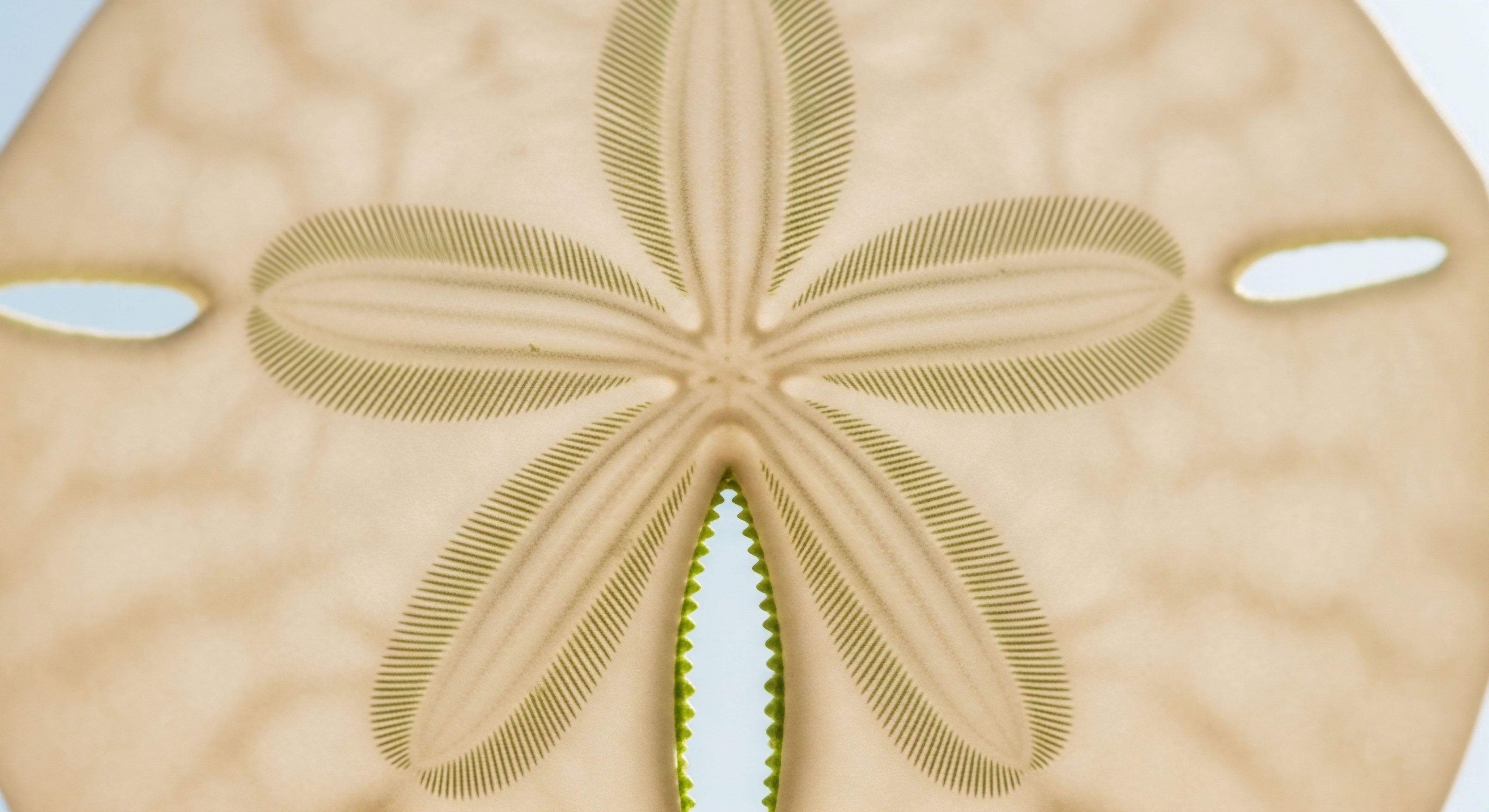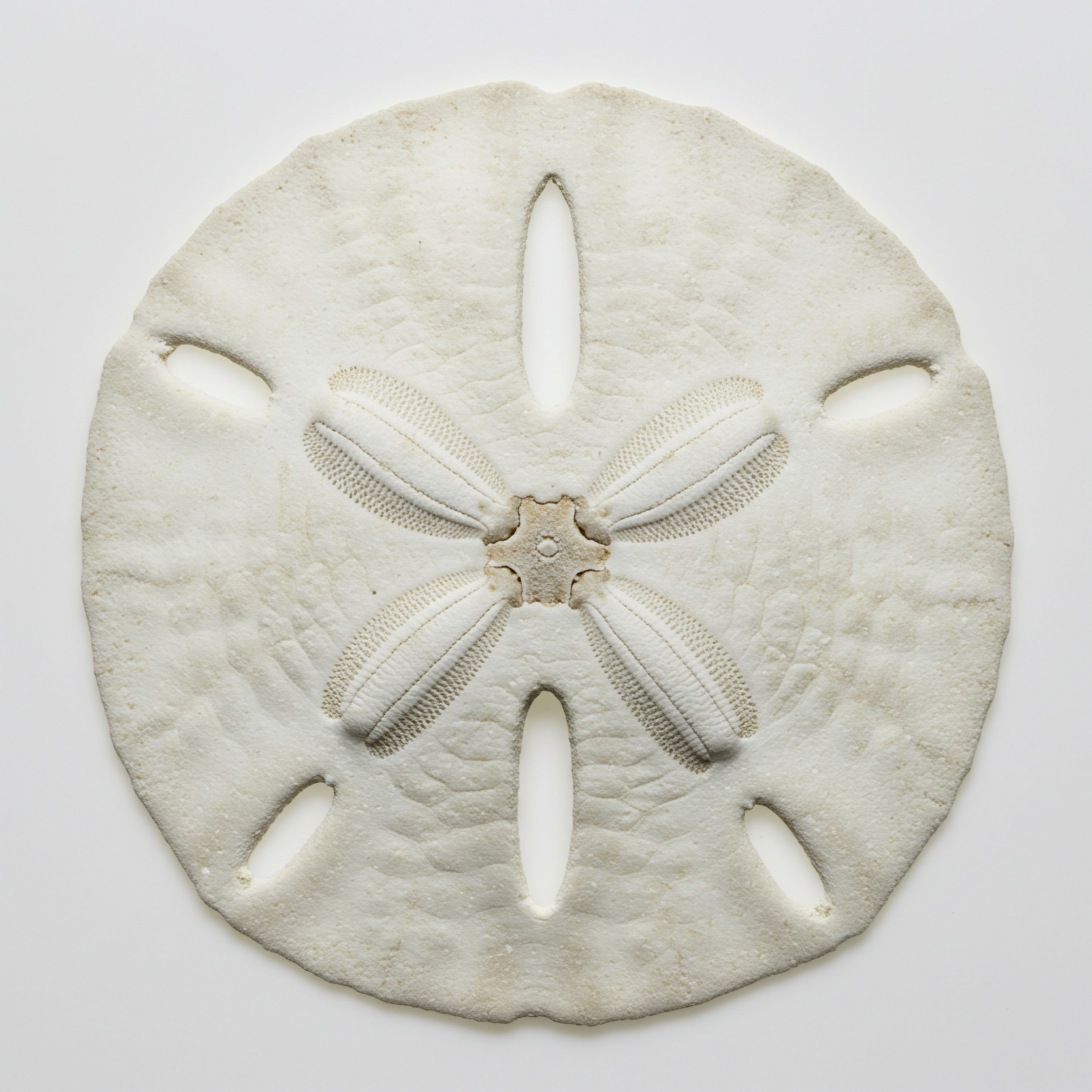

Fundamentals
You may have noticed changes in the mirror, a subtle loss of firmness in your skin, or a texture that feels different to the touch. These shifts are often attributed to the simple passage of time, yet they are deeply rooted in the intricate and powerful world of your endocrine system.
The conversation around hormonal health frequently centers on internal well-being, but the skin, our body’s largest organ, is a direct and visible reflection of our internal hormonal state. When we speak of “off-label” beauty uses of hormone replacement therapy (HRT), we are looking at a clinical application that extends beyond its primary, approved purposes to address these aesthetic changes.
This approach is grounded in the understanding that hormones are the fundamental messengers that regulate cellular function throughout the body, including the very cells responsible for your skin’s strength, hydration, and vitality.
The term “off-label” simply means a medication is being prescribed for a purpose other than what it was originally approved for by regulatory bodies like the FDA. This is a common and legal practice in medicine when a physician, based on clinical evidence and experience, determines that a treatment can benefit a patient for a different condition.
In the context of aesthetic medicine, the off-label application of hormonal therapies is based on a wealth of scientific observation about how these molecules influence skin biology. The decline in specific hormones, particularly estrogen during menopause, is directly linked to a decrease in collagen production, skin thickness, and moisture retention. Therefore, replenishing these hormones is not about chasing an artificial ideal of youth; it is about restoring a key biological component that your skin requires to function optimally.

The Cellular Basis of Hormonal Skin Aging
To appreciate how hormonal optimization protocols can benefit the skin, it is helpful to understand what is happening at a microscopic level. Your skin’s dermis, the layer responsible for its structure and resilience, is rich with specialized cells called fibroblasts. These fibroblasts are the factories that produce collagen and elastin, the proteins that give skin its firmness and elasticity.
Crucially, these fibroblasts have receptors for hormones, especially estrogen. Think of these receptors as docking stations. When estrogen is abundant, it binds to these receptors and signals the fibroblasts to maintain robust collagen production. As estrogen levels decline with age, fewer signals are sent, and the collagen factories slow down.
The result is thinner, less elastic skin that is more prone to wrinkling. Systemic hormone therapy, by restoring circulating estrogen levels, can re-engage these cellular mechanisms, supporting the skin’s structural integrity from within.
The skin is a primary target for sex hormones, and its appearance is a direct reflection of underlying endocrine health.
This process is about providing the necessary biological tools for your cells to perform their functions correctly. It is a physiological recalibration aimed at supporting the skin’s own regenerative capabilities. The aesthetic improvements observed are a secondary effect of restoring a more balanced and functional hormonal environment.
This is a fundamentally different approach from topical treatments that work exclusively on the surface. While essential, surface treatments do not address the systemic hormonal shifts that are driving the aging process at a deeper level. The goal of hormonal support is to rebuild the biological foundation upon which healthy skin is built.


Intermediate
Moving beyond foundational concepts, a deeper examination of the off-label aesthetic applications of hormonal therapies reveals specific protocols designed to leverage the biological actions of different hormones. The primary objective is to counteract the age-related decline in skin quality by restoring key hormonal signals that regulate dermal health.
This involves a sophisticated understanding of how estrogen, testosterone, and even growth hormone-releasing peptides interact with skin cells to modulate their function. The clinical approach is one of systemic support, aiming to rebuild the skin’s structural matrix from the inside out.

Estrogen the Architect of Skin Hydration and Structure
Estrogen is arguably the most significant hormone for skin health in women. Its decline during perimenopause and menopause precipitates a cascade of changes, including decreased collagen, reduced thickness, and impaired barrier function. Clinical protocols utilizing estradiol, the most potent form of estrogen, aim to mitigate these effects.
Systemic administration via transdermal patches or gels is often preferred to provide stable, continuous levels of the hormone. This method allows estradiol to circulate and bind to estrogen receptors (ER-α and ER-β) present on dermal fibroblasts and keratinocytes.
This binding directly stimulates the synthesis of Type I and Type III collagen, the two most abundant types in the skin, leading to improved dermal thickness and elasticity. Furthermore, estrogen enhances the production of hyaluronic acid, a key molecule for skin hydration, which contributes to a plumper, more luminous appearance. A meta-analysis of multiple studies confirmed that menopausal hormone therapy significantly increases skin elasticity and collagen content.

How Does Testosterone Influence Female Skin?
While often considered a male hormone, testosterone plays a vital, albeit complex, role in female physiology, including skin health. In women, testosterone is prescribed off-label at low doses, typically via subcutaneous injections of Testosterone Cypionate (10-20 units weekly), to address symptoms like low libido and fatigue.
A secondary benefit of this optimization can be seen in the skin. Testosterone contributes to sebum production, which can enhance the skin’s protective lipid barrier and alleviate dryness. Some studies suggest that testosterone has an anabolic, or building, effect on tissues, which may contribute to maintaining skin thickness.
However, the balance is delicate. Excess testosterone can lead to unwanted androgenic side effects, such as acne or hirsutism (unwanted facial hair), because it can overstimulate the sebaceous glands and hair follicles. For this reason, protocols for women use very low doses, and an aromatase inhibitor like Anastrozole may be co-administered to control the conversion of testosterone into estrogen, maintaining a precise hormonal balance.
Systemic hormonal protocols work by re-establishing the biochemical signaling necessary for collagen synthesis and cellular repair.
| Hormone/Peptide | Primary Aesthetic Target | Mechanism of Action | Common Administration Route |
|---|---|---|---|
| Estrogen (Estradiol) | Wrinkles, Dryness, Thinning Skin | Binds to fibroblast receptors, stimulating collagen and hyaluronic acid synthesis. | Transdermal Patch or Gel |
| Testosterone (Low-Dose) | Skin Dryness and Thickness | Increases sebum production and may have an anabolic effect on dermal tissue. | Subcutaneous Injection |
| Growth Hormone Peptides (e.g. Ipamorelin) | Overall Skin Rejuvenation, Firmness | Stimulates the pituitary to release natural growth hormone, which promotes cellular repair and regeneration. | Subcutaneous Injection |

The Role of Growth Hormone Peptides
For individuals seeking broader anti-aging benefits, Growth Hormone Peptide Therapy offers another avenue. Peptides like Ipamorelin, often combined with CJC-1295, are growth hormone secretagogues. They work by stimulating the pituitary gland to produce and release the body’s own natural growth hormone (GH).
GH levels naturally decline with age, and this decline is associated with many signs of aging, including thinning skin. By elevating GH levels, these peptides can enhance cellular regeneration and repair throughout the body. In the skin, this translates to increased fibroblast activity and collagen synthesis, leading to improved firmness and a more youthful texture. Because these peptides support the body’s own production pathways, they are considered a more physiologic approach to hormonal optimization for rejuvenation.
These protocols represent a targeted, evidence-based strategy for addressing the aesthetic signs of aging at their systemic source. By carefully recalibrating the body’s internal messaging system, it is possible to support the skin’s inherent ability to maintain its structure, hydration, and vitality.


Academic
The off-label application of hormonal therapies for aesthetic purposes represents a clinical translation of endocrinological and dermatological science. This practice moves beyond treating deficiency symptoms and into the realm of physiological optimization, where the primary endpoint is the structural and functional integrity of the skin.
A sophisticated analysis of this approach requires an examination of the molecular mechanisms of hormone action on cutaneous cells, the comparative efficacy of different therapeutic agents, and the systemic biological context in which these interventions occur. The central thesis is that age-related skin deterioration is a direct consequence of the loss of specific hormonal signaling, and that restoration of these signals can partially reverse or delay this process.

Molecular Endocrinology of the Skin
The skin is a major endocrine organ, both responding to and synthesizing hormones. The most critical interactions for aesthetic purposes involve the sex steroids and growth factors. Estrogen’s effects are mediated primarily through two nuclear receptors, Estrogen Receptor Alpha (ERα) and Estrogen Receptor Beta (ERβ), both of which are expressed in dermal fibroblasts, epidermal keratinocytes, and melanocytes.
Upon binding estradiol, these receptors form dimers and act as transcription factors, upregulating genes responsible for the synthesis of collagen I and III, elastin, and hyaluronic acid. Clinical studies have quantified this effect, showing that postmenopausal estrogen therapy can prevent the estimated 30% loss of skin collagen that occurs in the first five years after menopause.
The choice of estrogen is also relevant; estriol, a weaker estrogen with a higher affinity for ERβ, is sometimes used in topical preparations for its localized effects, though systemic therapy with estradiol provides a more global impact.
Testosterone’s role is mediated by the androgen receptor (AR), also present in keratinocytes, sebaceous glands, and dermal papilla cells of hair follicles. While essential for maintaining sebum production and skin thickness, the conversion of testosterone to dihydrotestosterone (DHT) by the enzyme 5-alpha reductase can lead to androgenic alopecia in genetically predisposed individuals.
Therefore, female protocols utilize low-dose testosterone to achieve anabolic benefits while minimizing androgenic side effects. The concurrent use of an aromatase inhibitor like Anastrozole is a key component of advanced protocols, preventing the aromatization of testosterone to estradiol. This allows for the independent optimization of both hormones, a critical aspect of personalized endocrine management.

What Is the Systemic Impact of Peptide Therapy?
Growth hormone peptide therapies, such as Sermorelin or the combination of Ipamorelin/CJC-1295, operate at a higher level of the endocrine cascade. These peptides are analogues of Growth Hormone-Releasing Hormone (GHRH) or Ghrelin mimetics. They act on the pituitary gland to stimulate the pulsatile release of endogenous Growth Hormone (GH).
GH then travels to the liver and other tissues, stimulating the production of Insulin-Like Growth Factor 1 (IGF-1). IGF-1 is a potent anabolic factor that promotes cellular proliferation and protein synthesis in virtually all tissues, including the skin. It enhances fibroblast proliferation and extracellular matrix production.
This systemic anabolic effect, initiated by a targeted peptide signal, is what drives the cutaneous benefits of improved skin thickness, elasticity, and wound healing. The therapeutic advantage of peptides is their ability to restore a more youthful pattern of GH secretion, as opposed to the direct administration of synthetic HGH, which can carry greater risks.
Hormonal therapies for aesthetic purposes are a form of functional medicine, aimed at restoring the physiological processes that maintain skin health.
The following table details the cellular targets and molecular outcomes of these hormonal interventions.
| Therapeutic Agent | Cellular Target | Receptor | Key Molecular Outcome |
|---|---|---|---|
| Estradiol | Fibroblasts, Keratinocytes | ERα, ERβ | Upregulation of COL1A1, COL3A1 genes; increased hyaluronic acid synthase activity. |
| Testosterone | Sebocytes, Fibroblasts | Androgen Receptor (AR) | Increased sebum lipid synthesis; potential anabolic effect on dermal protein. |
| Ipamorelin/CJC-1295 | Somatotrophs (Pituitary) | GHRH-R, Ghrelin Receptor | Increased pulsatile GH release, leading to elevated systemic IGF-1 levels. |
- Systemic vs. Topical ∞ While topical applications of hormones like estriol can provide localized benefits by directly targeting facial skin, which has a high concentration of estrogen receptors, they do not address the systemic hormonal milieu. Systemic therapies, such as injections or transdermal patches, provide a comprehensive recalibration of the endocrine system, influencing all tissues, including the skin, for a more holistic anti-aging effect.
- Safety and Monitoring ∞ The off-label use of these potent molecules necessitates rigorous clinical oversight. Baseline and follow-up blood work to monitor hormone levels, lipid panels, and other relevant biomarkers is standard practice. For women, this includes careful consideration of personal and family history regarding hormone-sensitive cancers. The principle is to use the lowest effective dose to achieve the desired physiological effect while minimizing risk.
- Future Directions ∞ Research continues to explore more targeted hormonal modulators. The development of Selective Estrogen Receptor Modulators (SERMs) that could provide the skin benefits of estrogen without stimulating breast or uterine tissue is an active area of investigation. Similarly, the refinement of peptide therapies aims to create even more specific and safer protocols for promoting tissue regeneration and longevity.

References
- Lephart, Edwin D. “A review of the role of estrogen in dermal aging and facial attractiveness in women.” Journal of Cosmetic Dermatology, vol. 17, no. 3, 2018, pp. 282-288.
- Verdier-Sévrain, Sylvie, and Frédéric Bonte. “Skin hydration ∞ a review on its molecular mechanisms.” Journal of Cosmetic Dermatology, vol. 6, no. 2, 2007, pp. 75-82.
- Raine-Fenning, N. J. et al. “The effect of classical and novel forms of hormone replacement therapy on skin collagen.” British Journal of Dermatology, vol. 146, no. 1, 2002, pp. 18-25.
- Thornton, M. Julie. “Estrogens and aging skin.” Dermato-endocrinology, vol. 5, no. 2, 2013, pp. 264-270.
- Brincat, M. P. et al. “A study of the decrease of skin collagen content, skin thickness, and bone mass in the postmenopausal woman.” Obstetrics & Gynecology, vol. 70, no. 6, 1987, pp. 840-845.
- Glaser, D. A. et al. “The effects of hormone replacement therapy on the skin.” Journal of the American Academy of Dermatology, vol. 45, no. 5, 2001, pp. 639-648.
- Son, Eun-Hee, et al. “Topical application of 17β-estradiol increases skin thickness and hyaluronic acid concentration in hairless mice.” Journal of Dermatological Science, vol. 32, no. 2, 2003, pp. 159-166.
- Sator, P. G. et al. “A prospective, randomized, double-blind, placebo-controlled study on the influence of a combination of oral contraceptives containing drospirenone on the skin.” Cutaneous and Ocular Toxicology, vol. 28, no. 2, 2009, pp. 73-78.
- Wohlrab, J. and W. C. Marsch. “The role of peptides in skin care.” Journal of the German Society of Dermatology, vol. 2, no. 1, 2004, pp. 1-8.
- Fields, K. et al. “Bioidentical-identical hormones, peptides, and the cutting edge of anti-aging.” Journal of Drugs in Dermatology, vol. 8, no. 6, 2009, pp. 532-536.

Reflection
You have now seen the biological framework that connects your internal hormonal symphony to the visible health of your skin. The data and mechanisms presented offer a clinical rationale for why you might be experiencing certain changes and how they can be addressed at their physiological root.
This knowledge is the first, most crucial step. It shifts the perspective from one of passive acceptance of aging to one of active, informed management of your own biology. The path forward involves a personal inquiry into your own unique hormonal state.
What you have learned here is the map; the next step is to understand your own territory through careful assessment and professional guidance. This journey is about reclaiming function and vitality, allowing your external appearance to be a true reflection of your internal health.

Glossary

hormone replacement therapy

hormonal therapies

skin thickness

growth hormone

dermal fibroblasts

hyaluronic acid

skin elasticity

subcutaneous injections

aromatase inhibitor like anastrozole

ipamorelin

cellular regeneration

collagen synthesis

androgenic alopecia




